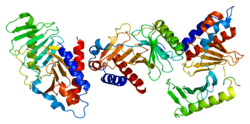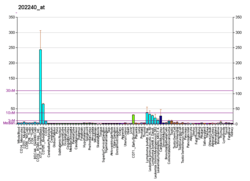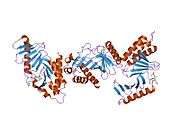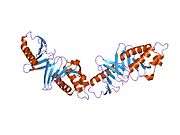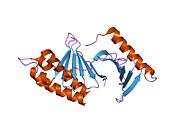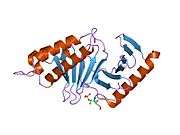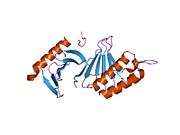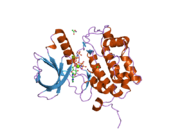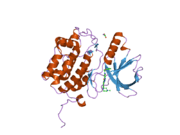PLK1
Serine/threonine-protein kinase PLK1, also known as polo-like kinase 1 (PLK-1) or serine/threonine-protein kinase 13 (STPK13), is an enzyme that in humans is encoded by the PLK1 (polo-like kinase 1) gene.[5]
Structure
PLK1 consists of 603 amino acids and is 66kDa. In addition to the N-terminus kinase domain, there are two conserved polo-box regions of 30 amino acids at the C-terminus. Kinase activity is regulated at least in part, by the polo-boxes that are functionally important for both auto-inhibition and subcellular localization.[6]
Localization
During interphase, PLK1 localizes to centrosomes. In early mitosis, it associates with mitotic spindle poles. A recombinant GFP-PLK1 protein localizes to centromere/kinetochore region, suggesting a possible role for chromosome separation.[7]
Cell cycle regulation
Plk1 is an early trigger for G2/M transition. Plk1 supports the functional maturation of the centrosome in late G2/early prophase and establishment of the bipolar spindle. Plk1 phosphorylates and activates cdc25C, a phosphatase that dephosphorylates and activates the cyclinB/cdc2 complex. Plk phosphorylates and activates components of the anaphase-promoting complex (APC). The APC, which is activated by Fizzy-Cdc20 family proteins, is a cell cycle ubiquitin-protein ligase (E3) that degrades mitotic cyclins, chromosomal proteins that maintain cohesion of sister chromatids, and anaphase inhibitors. Abnormal spindle (Asp), a Polo kinase substrate, is a microtubule-associated protein essential for correct behavior of spindle poles and M-phase microtubules. Plk1 localizes to the central region of the spindle in late mitosis and associates with kinesin-like protein CHO1/MKLP1. The homologous motor protein in Drosophila is the pavarotti gene product (PAR).[8]
Studies have shown that the loss of PLK1 expression can induce pro-apoptotic pathways and inhibit growth. Based on yeast and murine studies of meiosis, human PLK1 may also have a regulatory function in meiosis. S. cerevisiae polo kinase CDC5 is required to phosphorylate and remove meiotic cohesion during the first cell division. In CDC5 depleted cells, kinetochores are bioriented during meiosis I, and Mam1, a protein essential for coorientation, fails to associate with kinetochores. CDC5 is believed to have roles in sister-kinetochore coorientation and chromosome segregation during meiosis I.[9]
Role in tumorigenesis
Plk1 is considered a proto-oncogene, whose overexpression is often observed in tumor cells. Aneuploidy and tumorigenesis can also result from centrosome abnormality, particularly centrosome amplification defects. Centrosome duplication and maturation regulated by Plk1 occurs from late S phase to prophase. Abnormal centrosome amplification may lead to multipolar spindles and results in unequal segregation of chromosomes.Plk1 overexpression also increases the centrosome size and/or centrosome number, which will also lead to improper segregation of chromosomes, aneuploidy, and tumorigenesis.
Oncogenic properties of PLK1 are believed to be due to its role in driving cell cycle progression. Supporting evidence comes from the overexpression studies of PLK1 in NIH3T3 cell line. These cells become capable of forming foci and growing in soft agar and more importantly, these cells can form tumors in nude mice due to PLK1 overexpression.[10]
PLK1 has also been linked to known pathways that are altered during the neoplastic transformation. Retinoblastoma tumor suppressor (RB) pathway activation results in the repression of PLK1 promoter in a SWI/SNF chromatin remodeling complex dependent manner. In case of RB inactivation, PLK1 expression seems to be deregulated. This new finding suggests that PLK1 may be a target of the retinoblastoma tumor suppressor (RB) pathway.
Moreover, PLK1 seems to be involved in the tumor suppressor p53 related pathways. Evidence suggests that PLK1 can inhibit transactivation and pro-apoptotic functions of p53 function by physical interaction and phosphorylation.[11]
Clinical significance
PLK1 is being studied as a target for cancer drugs. Many colon and lung cancers are caused by K-RAS mutations. These cancers are dependent on PLK1.
When PLK1 expression was silenced with RNA interference in cell culture, K-RAS cells were selectively killed, without harming normal cells.[12][13]
PLK1 inhibitor volasertib is being evaluated in clinical trials for use in acute myeloid leukemia (AML).[14] A combination of PLK1 and EGFR inhibition overcomes T790M-mediated drug resistance in vitro and in vivo in non-small cell lung cancer (NSCLC).[15] In HNSCC mutations of the AJUBA mediate sensitivity to treatment with cell-cycle inhibitors including Plk1 inhibitor volasertib.[16]. In mesenchymal NSCLC cells, cMet phosphorylation is regulated by Plk1‐mediated vimentin phosphorylation via β1‐integrin. The combination of cMet and Plk1 inhibition led to significant tumor regression in NSCLC in vivo models treated with clinically relevant drugs.[17]
Rigosertib is an experimental RAS/PI3K/PLK1 inhibitor.[18]
Interactions
PLK1 has been shown to interact with:
Structural analysis has been used to explain the broad specificity of PLK1.[28]
See also
- Polo-like kinases, the gene family that PLK1 belongs to
References
- GRCh38: Ensembl release 89: ENSG00000166851 - Ensembl, May 2017
- GRCm38: Ensembl release 89: ENSMUSG00000030867 - Ensembl, May 2017
- "Human PubMed Reference:". National Center for Biotechnology Information, U.S. National Library of Medicine.
- "Mouse PubMed Reference:". National Center for Biotechnology Information, U.S. National Library of Medicine.
- Holtrich U, Wolf G, Bräuninger A, Karn T, Böhme B, Rübsamen-Waigmann H, Strebhardt K (March 1994). "Induction and down-regulation of PLK, a human serine/threonine kinase expressed in proliferating cells and tumors". Proceedings of the National Academy of Sciences of the United States of America. 91 (5): 1736–40. Bibcode:1994PNAS...91.1736H. doi:10.1073/pnas.91.5.1736. PMC 43238. PMID 8127874.
- Cheng KY, Lowe ED, Sinclair J, Nigg EA, Johnson LN (November 2003). "The crystal structure of the human polo-like kinase-1 polo box domain and its phospho-peptide complex". The EMBO Journal. 22 (21): 5757–68. doi:10.1093/emboj/cdg558. PMC 275415. PMID 14592974.
- Lee KS, Oh DY, Kang YH, Park JE (January 2008). "Self-regulated mechanism of Plk1 localization to kinetochores: lessons from the Plk1-PBIP1 interaction". Cell Division. 3: 4. doi:10.1186/1747-1028-3-4. PMC 2263035. PMID 18215321.
- van de Weerdt BC, Medema RH (April 2006). "Polo-like kinases: a team in control of the division". Cell Cycle. 5 (8): 853–64. doi:10.4161/cc.5.8.2692. PMID 16627997.
- Soung NK, Park JE, Yu LR, Lee KH, Lee JM, Bang JK, et al. (April 2009). "Plk1-dependent and -independent roles of an ODF2 splice variant, hCenexin1, at the centrosome of somatic cells". Developmental Cell. 16 (4): 539–50. doi:10.1016/j.devcel.2009.02.004. PMC 2741019. PMID 19386263.
- Malumbres M, Barbacid M (February 2007). "Cell cycle kinases in cancer". Current Opinion in Genetics & Development. 17 (1): 60–5. doi:10.1016/j.gde.2006.12.008. PMID 17208431.
- Liu X, Erikson RL (May 2003). "Polo-like kinase (Plk)1 depletion induces apoptosis in cancer cells". Proceedings of the National Academy of Sciences of the United States of America. 100 (10): 5789–94. Bibcode:2003PNAS..100.5789L. doi:10.1073/pnas.1031523100. PMC 156279. PMID 12732729.
- Downward J, Finding the weakness in cancer, N Engl J Med, 361:922, Aug. 27, 2009
- Luo J, Emanuele MJ, Li D, Creighton CJ, Schlabach MR, Westbrook TF, et al. (May 2009). "A genome-wide RNAi screen identifies multiple synthetic lethal interactions with the Ras oncogene". Cell. 137 (5): 835–48. doi:10.1016/j.cell.2009.05.006. PMC 2768667. PMID 19490893.
- Van den Bossche J, Lardon F, Deschoolmeester V, De Pauw I, Vermorken JB, Specenier P, et al. (July 2016). "Spotlight on Volasertib: Preclinical and Clinical Evaluation of a Promising Plk1 Inhibitor". Medicinal Research Reviews. 36 (4): 749–86. doi:10.1002/med.21392. PMID 27140825.
- Wang Y, Singh R, Wang L, Nilsson M, Goonatilake R, Tong P, et al. (July 2016). "Polo-like kinase 1 inhibition diminishes acquired resistance to epidermal growth factor receptor inhibition in non-small cell lung cancer with T790M mutations". Oncotarget. 7 (30): 47998–48010. doi:10.18632/oncotarget.10332. PMC 5216995. PMID 27384992.
- Zhang M, Singh R, Peng S, Mazumdar T, Sambandam V, Shen L, et al. (April 2017). "Mutations of the LIM protein AJUBA mediate sensitivity of head and neck squamous cell carcinoma to treatment with cell-cycle inhibitors". Cancer Letters. 392: 71–82. doi:10.1016/j.canlet.2017.01.024. PMC 5404895. PMID 28126323.
- Singh R, Peng S, Viswanath P, Sambandam V, Shen L, Rao X, et al. (May 2019). "Non-canonical cMet regulation by vimentin mediates Plk1 inhibitor-induced apoptosis". EMBO Molecular Medicine. 11 (5). doi:10.15252/emmm.201809960. PMC 6505578. PMID 31040125.
- Nuthalapati S, Zhou Q, Guo P, Lv H, Cosenza S, Reddy MV, et al. (September 2012). "Preclinical pharmacokinetic and pharmacodynamic evaluation of novel anticancer agents, ON01910.Na (Rigosertib, Estybon™) and ON013105, for brain tumor chemotherapy". Pharmaceutical Research. 29 (9): 2499–511. doi:10.1007/s11095-012-0780-y. PMID 22678771.
- Tsvetkov L, Xu X, Li J, Stern DF (March 2003). "Polo-like kinase 1 and Chk2 interact and co-localize to centrosomes and the midbody". The Journal of Biological Chemistry. 278 (10): 8468–75. doi:10.1074/jbc.M211202200. PMID 12493754.
- Zhou T, Aumais JP, Liu X, Yu-Lee LY, Erikson RL (July 2003). "A role for Plk1 phosphorylation of NudC in cytokinesis". Developmental Cell. 5 (1): 127–38. doi:10.1016/s1534-5807(03)00186-2. PMID 12852857.
- Shen M, Stukenberg PT, Kirschner MW, Lu KP (March 1998). "The essential mitotic peptidyl-prolyl isomerase Pin1 binds and regulates mitosis-specific phosphoproteins". Genes & Development. 12 (5): 706–20. doi:10.1101/gad.12.5.706. PMC 316589. PMID 9499405.
- Lu PJ, Zhou XZ, Shen M, Lu KP (February 1999). "Function of WW domains as phosphoserine- or phosphothreonine-binding modules". Science. 283 (5406): 1325–8. Bibcode:1999Sci...283.1325L. doi:10.1126/science.283.5406.1325. PMID 10037602.
- Lee M, Daniels MJ, Venkitaraman AR (January 2004). "Phosphorylation of BRCA2 by the Polo-like kinase Plk1 is regulated by DNA damage and mitotic progression". Oncogene. 23 (4): 865–72. doi:10.1038/sj.onc.1207223. PMID 14647413.
- Lin HR, Ting NS, Qin J, Lee WH (September 2003). "M phase-specific phosphorylation of BRCA2 by Polo-like kinase 1 correlates with the dissociation of the BRCA2-P/CAF complex". The Journal of Biological Chemistry. 278 (38): 35979–87. doi:10.1074/jbc.M210659200. PMID 12815053.
- Feng Y, Longo DL, Ferris DK (January 2001). "Polo-like kinase interacts with proteasomes and regulates their activity". Cell Growth & Differentiation. 12 (1): 29–37. PMID 11205743.
- Astrinidis A, Senapedis W, Henske EP (January 2006). "Hamartin, the tuberous sclerosis complex 1 gene product, interacts with polo-like kinase 1 in a phosphorylation-dependent manner". Human Molecular Genetics. 15 (2): 287–97. doi:10.1093/hmg/ddi444. PMID 16339216.
- Li J, Wang R, Gannon OJ, Rezey AC, Jiang S, Gerlach BD, et al. (November 2016). "Polo-like Kinase 1 Regulates Vimentin Phosphorylation at Ser-56 and Contraction in Smooth Muscle". The Journal of Biological Chemistry. 291 (45): 23693–23703. doi:10.1074/jbc.M116.749341. PMC 5095422. PMID 27662907.
- Huggins DJ, McKenzie GJ, Robinson DD, Narváez AJ, Hardwick B, Roberts-Thomson M, et al. (August 2010). "Computational analysis of phosphopeptide binding to the polo-box domain of the mitotic kinase PLK1 using molecular dynamics simulation". PLoS Computational Biology. 6 (8): e1000880. Bibcode:2010PLSCB...6E0880H. doi:10.1371/journal.pcbi.1000880. PMC 2920843. PMID 20711360.
